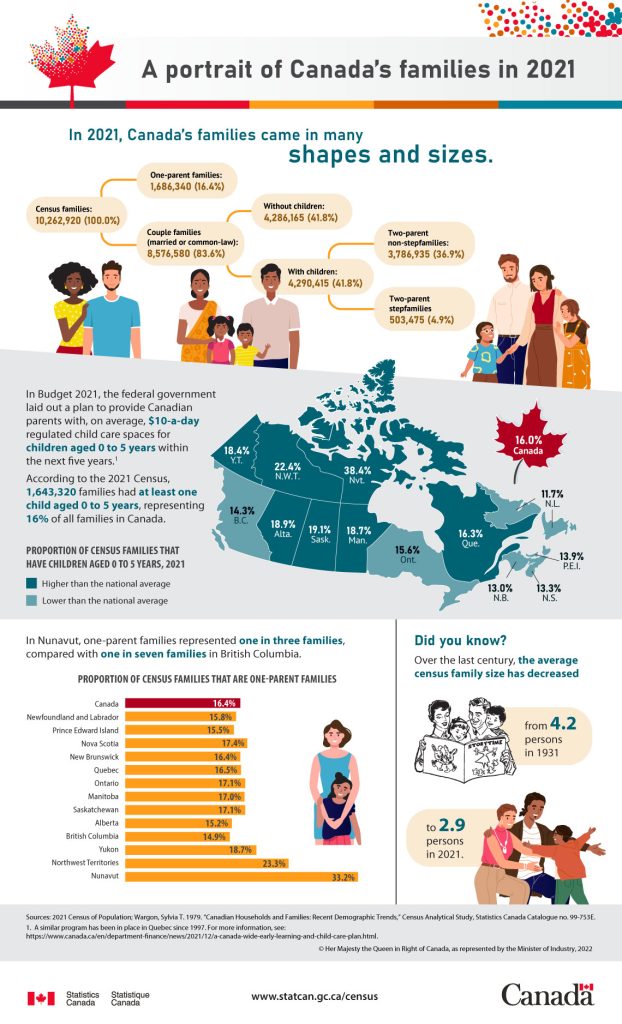7.2 Variations in Family Life

Learning Outcomes
By the end of this chapter, you’ll be able to:
- Recognize variations in family life.
- Describe the different forms of the family, including the nuclear family, single-parent families, cohabitation, same-sex couples, and unmarried individuals.
Overview of Family Structures
| Type of Family | Definitions and Recent Trends |
|---|---|
| One Parent Families |
|
| Couple Families |
|
| Staying Single |
|
The combination of husband, wife, and children that most Canadians believes constitutes a family is not representative of the majority of Canadian families. According to 2021 census data, married couples with children only accounted for approximately 34% of all families with children (Statistics Canada, 2025). Therefore, the nuclear family (married parents and children) structure in Canada is changing. Recent years have seen a rise in variations of the nuclear family such as common-law or cohabitating parents with children. One-parent households are also on the rise and now account for approximately 16% of families. It’s important to note that extended family structures also exist including combinations of parents, grandparents, aunts, uncles, and cousins living in the same home. Furthermore, more Canadians are choosing not to have children or less children than before. As noted in the 2021 census data, the average census family size has decreased from 4.2 persons in 1931 to 2.9 persons in 2021 (Statistics Canada, 2022a).
Stepfamilies, or blended families are an additional family element in two-parent homes. Historically, stepfamilies formed most often because of the death of a spouse, like in the 1970s TV sitcom The Brady Bunch. Contemporary stepfamilies are more commonly the result of the conjugal break down in previous relationships. The introduction of no fault divorce in Canada in the 1980s and the increasing prevalence of common-law relationships, contributed to the growth in numbers of the stepfamily. But since 1995, the number of parents living in stepfamilies has remained relatively stable (Vézina, 2012).
Changes in the traditional family structure raise questions about how such societal shifts affect children. For example, research, mostly from American sources, has shown that children living in homes with both parents grow up with more financial and educational advantages than children who are raised in single-parent homes (U.S. Census Bureau, 2010). Similarly, recent research from Canada explores how family structure can be used as an indirect measure of children’s family stability which is associated with their outcomes (Mitchell, 2023). For instance, family instability and exposure to repeated changes is associated with higher risks of behaviour problems, delinquency and poorer academic achievement (Mitchell, 2023).
Another change in family patterns if the surge of people staying single or cohabitating. Living alone is becoming a more common option for Canadians and can be based on a variety of factors such as religion or cultural expectations. Single men and women report social pressure to get married, but women face more scrutiny. However, the influx of people living alone may also be attributed to Canada’s aging population (older adults becoming widows) and young adults who are choosing to postpone starting a family (Statistics Canada, 2022c). On the other hand, couples who choose to cohabitate may feel less social stigma than previously. Some cohabitating couples may be using their time to ‘work out kinks’ in their relationships, saving money on living costs or trying to spend more time together. In fact, cohabitation or common-law marriage is much more prevalent in Quebec (39.9% of census families) and the Northern Territories (from 36.6% in Yukon to 50.3% in Nunavut) than in the rest of the country (an average of 15.7%, excluding Quebec and the three territories) (Statistics Canada, 2019).
Media Attributions
- A portrait of Canada’s families in 2021 © Statistics Canada used under Statistics Canada Open License

